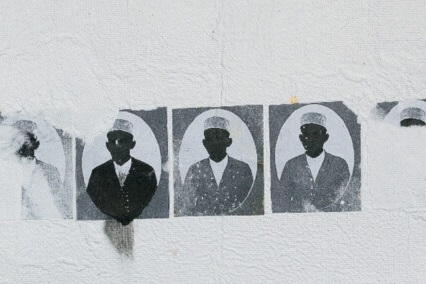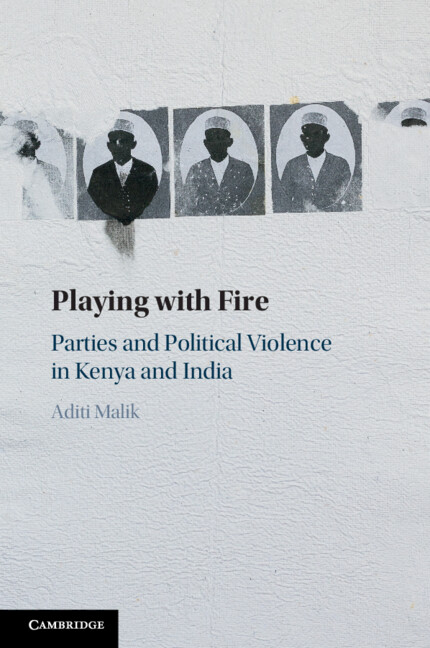
Political parties play vital roles in the healthy functioning of democratic regimes. They form the government and the opposition, provide structure to the electoral process, aggregate and channel citizens’ preferences, and promote democratic accountability. Yet, increasing global and comparative evidence suggests that parties are also key protagonists in events of violence around the world. From engaging in voter intimidation and the neutralization of political rivals in a direct sense to partnering with armed non-state actors in an indirect vein, parties are involved in myriad forms and modalities of political conflict today.
Playing with Fire delves into the puzzling phenomenon of party violence through a rare cross-regional comparison of Kenya and India, two countries marked by relatively high levels ethnic party violence. The book complements this comparison with the incorporation of data from chosen subnational sites to address two main questions. First, under what conditions do parties become vehicles for political violence? Second, why does the use of parties as instruments for conflict sometimes yield rich electoral dividends for political elites but generate significant costs at other times?
The book draws on a mixed-methods approach and an array of data—including event datasets on ethnic party violence, original quantitative data on party organization, and over 200 in-depth interviews conducted during fieldwork in both countries—to develop and substantiate its arguments. In so doing, it introduces party instability as a crucial conditioning factor that can shape elites’ decisions about 1) whether or not to supply party violence and 2) the scale at which to do so.
Centrally, Playing with Fire argues that party instability matters because it informs politicians and political party leaders’ calculations about the electoral costs and benefits that can be accrued through violence. Specifically, the book holds that places marked by unstable parties are more vulnerable to experiencing recurring and severe episodes of party conflict than those populated by durable parties. This is because the costs of violence—in terms of future negative consequences for elites—are lower in settings where parties are transient and fleeting. Put differently, the book proposes that unstable party contexts orient politicians to operate with truncated time horizons and thereby enable them to repeatedly orchestrate or sponsor party violence, including high-intensity conflict, by discounting the future costs of this choice. By contrast, stable party settings disincentivize recurring and severe violence by sensitizing politicians to costs that could be borne in the future.
Voter Sanctioning as a Cost of Party Violence
In theorizing the relationship between party instability and elites’ incentives for violence, the book pays particular attention to sanctioning from voters as a possible cost that elites can face. Much of the literature in political science that has grappled with elite-led episodes of political conflict has studied ordinary citizens as participants in or victims of violence. Yet, under certain conditions, citizens are also amply capable of holding nefarious leaders to account by voting against such politicians. Research on other objectionable elite behaviors—such as corruption, criminality, and personal wealth-accumulation—has persuasively demonstrated voters’ willingness to turn their backs on politicians who engage in such practices. We thus have good reasons to expect that citizens would also be willing to punish politicians who are responsible for violence, particularly when such violence results in consequences that affect broad groups of people or ethnic in-groups and out-groups alike.
During fieldwork in Kenya and India, I found that citizens were often keenly aware of the parties, and sometimes even the subnational candidates and leaders, who were responsible for political violence in their communities. This was especially true for episodes of conflict that had occurred some time ago. Furthermore, respondents frequently articulated the broad and destabilizing effects of violence on their lives. These effects ranged from revenue and property loss to heightened insecurity and vulnerability. Finally, numerous interviewees noted their disapproval of parties that were responsible for major episodes of conflict.
Yet, I found that compared to their Indian counterparts, respondents in Kenya—where political parties are highly transient—usually also emphasized a key difficulty they faced in holding violent politicians and parties to account. Specifically, many interviewees spoke about the instability of parties, and attendant political coalitions, as a hurdle to enacting sanctioning. With parties being fleeting, in other words, these interviewees held that their ability to punish politicians was relatively limited.
Politicians’ Calculations
In addition to conversations with ordinary citizens, I conducted dozens of interviews with politicians, political party leaders, and party members and functionaries in Kenya and India. These interviews crucially help us to open up the black box of political parties so as to better understand elite decision-making as it pertains to violence.
Substantively and collectively, my conversations with politicians, political party leaders, and party members and functionaries revealed that these individuals take voters’ sanctioning abilities into account as part of their calculations about whether and at what level to deploy violence. Although they occasionally miscalculate on these counts—that is, elites from stable parties sometimes become involved in high-intensity violence that later costs them—I generally find that recurring and severe episodes of party conflict are bets that are taken by politicians in unstable party settings.
With that being said, in both Kenya and India, I found that it was not uncommon for political elites to displace blame for violence onto rival parties and candidates. Moreover, in admitting to orchestration on the part of their organizations or colleagues, respondents typically framed conflict as being part and parcel of the competitive political landscape in which they were embedded. Despite these larger similarities, a key difference amongst this group of interviewees is that those in India often spoke of violence—particularly severe violence—as a risky strategy that could backfire upon them. By contrast, many political leaders in Kenya seemed to perceive party conflict as a viable tactic in their political toolkits.
Building on these insights, Playing with Fire argues that one reason major ethnic riots have declined in India since the early 1990s is because politicians have become wary of orchestrating or carrying out such violence. The book also suggests that newer modalities of ethnic conflict in the country—including low-level and targeted attacks against Muslims—are plausibly explained by the lower risks of voter sanctioning that such assaults stand to engender. By contrast, it shows that unstable parties not only incentivized party conflict in Kenya in the 1990s and 2000s, but are also vital to understanding the persistence of such violence in the wake of more recently implemented institutional reforms, such as devolution. Moreover, to the extent that Kenya avoided severe outbreaks of violence around the 2022 elections, my research holds that this was due to the strengthening of institutions beyond political parties, such as the Supreme Court. In order to further dampen the possibilities for party conflict in Kenya going forward, the book suggests that stabilizing political parties at their fundament should receive greater attention.
Central Contributions
In conclusion, the central contributions of Playing with Fire are three-fold. First, this is one of few books to develop and substantiate a theory about party violence as distinct phenomenon. Second, by incorporating data and original interviews with politicians and political party elites, the book enables us to go within political parties in novel ways. Third, the cross-regional comparison at the heart of the research contributes productively to comparative politics scholarship. While much literature in the subfield continues to rely on intra-country or intra-regional comparisons, Playing with Fire shows us that there is much to be learned about global phenomena such as party violence by drawing on country cases and data from different world regions.

Latest Comments
Have your say!